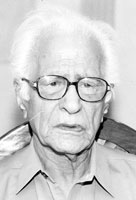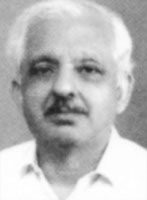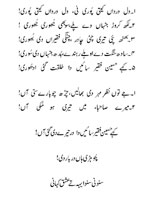About Shah Husayn and Madho
By Nadir Ali
Date:27-11-05
Source: The News
 Shah Husayn
Shah Husayn
within Reach
Muzaffar Ghaffaar
Published by Ferozsons, Lahore
Pages: 1141 (Three Volumes)
Price: Rs 2095
In book reviews we are long on accolades, but short on credibility. I would like the reader to take a careful look at this review. The twenty seven volumes, of which two on Bulleh Shah were reviewed on these pages in September 2005, and three are under review, are an epoch-making work. It indeed is the publishing event of the year. I can only fall short of compliments. It represents 15 years of meticulous hard work with the best scholars of Punjabi literature studied and consulted.
We have a word in Punjab for the kind of person Muzaffar Ghaffaar is. It is "aahri" (an organised/organising person). In Punjabi they say, "Ik aahri tay sau kamay" (an organised/organising person is equal to a hundred men working). Muzaffar is like a factory working. But that may not be appropriate symbolism for a committed and creative person with his heart in the right place.
Instead of routine remarks about the book and the author, I would like to give the reader a peep  into the work under review. These glimpses may be scant for a discussion on a book of three volumes. But as most readers are not familiar with Punjabi poetry, and especially Shah Husayn's poetry, this look will be of great value. I am reviewing merely the translation, and not the exhaustive notes, of only one short poem out of one hundred and three 'kaafis' that Shah Husayn wrote. Shah remained obscure for a couple of centuries and was only accidentally discovered by Dr Mohan Singh Diwana in 1940s. Yet he is one of the best poets of the Punjabi language.
into the work under review. These glimpses may be scant for a discussion on a book of three volumes. But as most readers are not familiar with Punjabi poetry, and especially Shah Husayn's poetry, this look will be of great value. I am reviewing merely the translation, and not the exhaustive notes, of only one short poem out of one hundred and three 'kaafis' that Shah Husayn wrote. Shah remained obscure for a couple of centuries and was only accidentally discovered by Dr Mohan Singh Diwana in 1940s. Yet he is one of the best poets of the Punjabi language.
Muzaffar has selected the best of his 150 odd compositions available for inclusion in the book under review. This is the best and most correct selection of Shah Husayn's work published to date. Incidentally, I too have seriously studied this poet for the last 30 years and have been writing about him for the last 15 years. I can say without fear of contradiction that this is the best work done in English about any of the classical Punjabi poetry in India or Pakistan. I am reproducing below the translation of the poem that I have selected to illustrate the unmatchable quality of this work. The author, despite his long devotion to the study of Punjabi classics, is however partial to the Western as well as an elite sensibility. I have chosen only a couple of lines to show this bias.
 The poem runs as below: 1 The heart was completed by the pain, heart pain let nothing remain!
The poem runs as below: 1 The heart was completed by the pain, heart pain let nothing remain!
2 Those who've got millions, they too go to pieces, sorrows sustain!
3 Into fire your white shawl! Good the faqeer's blanket plain!
4 Truthful in vials of congress remain, sage their dauntless domain!
5 Says Husayn, the lord's devotee, incomplete goes the world's campaign!
Because of constraints of space I have not repeated the refrain with each line, which is a feature of the 'Kaafi' form. Now, carefully consider this translation line by line and word by word. Firstly, it follows the original rhyme scheme in verse -- that is like wearing a straitjacket and performing a dance -- but does not falter at all. Now consider the words and phrases -- "blanket plain" for "bhuri," congress for "Sangat," sage for "budh" and dauntless domain for "suri" which means both perfect and heroic. This is excellent translation. Also consider the rhyme and the meter. This is blood-and-sweat work. Much easier said than done.
Now for the lines the translation of which I differ with, but only in interpretation. I had to look long and hard to locate this rarely shown ideological faultline, because the writer's comprehensive notes cover all points of view. The following couplet is a matchless translation and is one of my favourites.
1 If you regard me into kind regard, the pavilion I'd enter sleep intimate!
2 O, lord becoming yours I'm consummate!
But at the end of the same composition Muzaffar has an ideological problem:
"Says Husayn the lord's devotee, I am a bitch at your gate!"
He has a problem with the word bitch. He considers it a caricature. Most people see the abusive connotation of the word bitch. Here it is a symbol of devotion with humility. Most great masters in Punjabi have used it. The same image shows up elsewhere.
"Of shrine I am sweepress."
Muzaffar again has problem with the humble "sweepress." He probably does not know that the Odes to the Sweepress (Chooratri Nama) is a separate genre in classic Punjabi poetry. Waris Shah is also credited with a Chooratri Nama printed along with Heer in Naval Kishore's edition. The sweepress, the humblest of the humble scavengers, is an ideal symbol for the underclass.
Chooratri Namas were all love poems to make the irony doubly poignant.All the great Punjabi masters being thorough-bred 'communists', used this interesting form of symbolism. Najm Hussain Syed's exercise in this genre runs as below.
"O, girls listen to this love story!"
One jarring note in this otherwise great book is the biographical note on Shah Husayn. He was not called Madho Lal Husayn by anyone until 400 years after he lived. The writer of Tahqiqat-e-Chishti in the 19th century was the first one to call him Madho Lal Hussain. Diwan Madho Lal was the successor saint, 'khalifa' of Husayn, to whom kings paid court. He was, during Husayn's life time, a high official with Maan Singh, the famous general of King Akbar.
In a dozen books quoted by Shafqat Tanvir Mirza in his works Shah Husayn is not called Madho Lal Husayn anywhere. He was Lal Husayn (the loving faqeer) as in Lal Shahbaz Qalander. Shah Husayn called himself Lal Husayn and Shah Husayn in some of his poems. Please note that Shah Husayn and Madho are not buried in one grave as Muzaffar writes -- they could not be with their deaths being nearly half a century apart. The whole biographical note needs to be revised. The relationship between the mentor and the devotee here is same as that between Rumi and Shams Tabrez, Amir Khusro and Khwaja Nizam-ud-Din Aulia, Bulleh Shah and Shah Anayat and Nosho Pir with Shah Rehman.